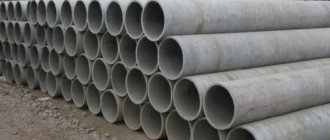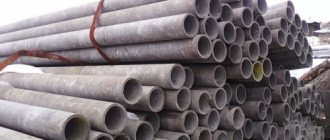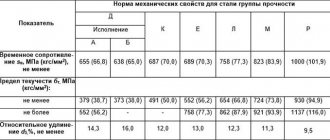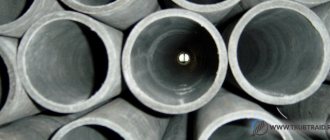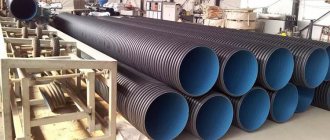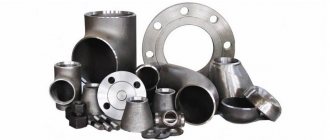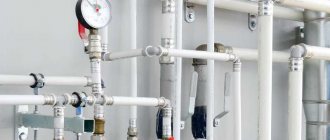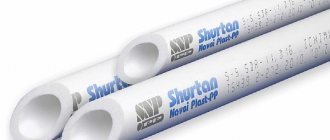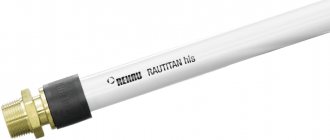Polypropylene pipes, fittings and components are used in plumbing and heating systems due to the versatility of the material and its excellent performance properties. Lightweight pipes that are not subject to the harmful effects of moisture and corrosion, that do not collapse under the influence of chemicals, and with constant permeability throughout their entire service life - all this is provided by polypropylene.
However, only compliance with approved quality standards of production, packaging, and labeling allows one to obtain such a result. Only pipes manufactured in accordance with all technical provisions will have all the specified advantages due to the original raw materials and methods of its processing.
Standard GOST R 52134-2003: main provisions of the document
GOST R 52134-2003 is the only standard that regulates the quality and determines the characteristics of pipes made of various thermoplastic materials, as well as fittings and connecting elements used in heating and water supply systems. The standard applies to pipes made from the following thermoplastics:
- PVC polyvinyl chloride, unplasticized (PVC-U, UPVC) and chlorinated (PVC-C, CPVC);
- polypropylene and its copolymers (homopolymer, block copolymer, random copolymer);
- polyethylene (PE, PE);
- polybutene (PB, PB);
- cross-linked polyethylene (PE-X, PE-S).
For the above-mentioned polypropylene copolymers, the following symbols are accepted:
- homopolymer or PP type 1 (PP-H, PP-G);
- block copolymer or PP type 2 (PP-B, PP-B);
- random copolymer or PP type 3 (PP-R, PP-R).
The document, which is the only accepted quality standard for thermoplastic pipes, regulates such provisions as the dimensional characteristics of pipes, as well as operating conditions and properties that determine service life. This includes safety factors for materials, maximum operating temperatures and pressures that determine whether a pipe belongs to one class or another.
Guided by the document, you can evaluate the quality of the pipes, since a single standard has been developed that must be relied upon during inspection.
In addition, GOST R 52134-2003 is used to calculate the wall thickness of pipes - knowing the conditions of use and the required service life of the pipe, you can calculate what the pipes should be like and what material it is best to make them from.
At the same time, GOST R 52134-2003 does not contradict GOST 18599 and GOST 51613 - quality standards for PE and PVC pipes; these documents complement each other. When compiling it, international quality standards and requirements for the production and calculation of thermoplastic pipes were taken into account.
Reinforced communications for heating
When installing heating, special attention should be paid to reinforced polypropylene pipes. GOST R 52134 determines the thickness of products, which leads to the need to optimize the content of additives (when reinforced with glass fiber). To do this, it is necessary to take into account that the fiber fiber of the inner layer should not violate hygiene standards and not impair the reliability of the welding joint.
Note! Utilities reinforced with glass fiber are characterized by solidity, low thermal expansion and increased rigidity, which allows their use with smaller diameters.
Aluminum foil can be used in several ways:
- placement in the middle of the pipe wall;
- placement near the outer surface and connection by adhesive method;
- use of perforated foil in the middle of the pipe wall.
The latter method allows you to obtain a monolithic connection with the polymer, which improves the parameters of the finished product. When using non-perforated foil, the design has a multi-layer structure.
Polypropylene communications are an excellent alternative to metal ones due to their high strength and performance characteristics. The use of reinforcement gives pipes qualities that allow them to be effectively included in heating pipelines.
trubamaster.ru
Polypropylene pipes GOST R 52134 2003
There are general requirements applicable to polypropylene pipes for the installation of heating and water supply systems:
- these must be pressure pipes;
- have a circular cross-section;
- serve for transportation of both drinking and process water, coolant;
- used in residential and non-residential buildings of various sizes, as well as in production.
Polypropylene pipes for plumbing and heating systems are available in diameters from 10 to 1600 mm. Pipes with outer diameters not exceeding 160 mm can be produced either in the form of straight sections or wound on reels. Pipes with a diameter of 180 mm or more are produced strictly in the form of straight sections up to 24 m long.
The inner and outer sides of polypropylene pipes must be smooth, the presence of longitudinal waves and stripes is allowed so that they do not affect the overall diameter. Pipes must be painted evenly, in a color corresponding to that specified in the regulatory document. There should be no streaks, stripes, inclusions, as well as mechanical defects - cracks, inclusions of foreign materials. The appearance of the finished pipe is checked against a control sample approved in accordance with the standard.
Pipes must be tested for temperature stability and constant internal pressure using the “water in air” and “water in water” methods, respectively.
Symbols and markings of PVC pipes
The main parameters of pipes include the concepts and letter designations given below.
Pipe outer diameter d,
mm, – nominal value.
Wall thickness e,
mm, – nominal value.
Nominal values correspond to the minimum permissible values.
Long-term pipe strength considering MRS material,
MPa - denotes the pressure that the pipe wall can withstand under constant internal load over 50 years of operation at t = 20°C, rounded to R 10 or R 20 if it is less than or greater than 10 MPa, respectively.
Design voltage s,
MPa - indicates the limit of permissible pressure in the pipe wall at a constant internal load for 50 years of operation at t = 20 ° C, rounded to R 10 or R 20, if it is less than or more than 10 MPa, respectively, taking into account the safety factor of the material.
Maximum operating pressure pРMS,
MPa – limit of permissible pressure at constant internal load for 50 years of operation at t = 20°C, rounded to R 10 or R 20, if it is less than or more than 10 MPa, respectively, depending on the class and design stress of the pipe.
Pipe series S
– a quantity representing the ratio of s to pРMS.
Dimensional standard ratio SDR
– determined by the ratio of d to e, also equal to 2S + 1.
Nominal value PN,
bar - the same as
pРMS,
expressed in the unit of measurement bar, used only when classifying pipes;
Maximum operating pressure at set temperature MOP,
MPa is the limit of permissible pressure in a pipe as part of a pipeline at a constant internal load for 50 years of operation;
Pipe opacity H, %
— determined by testing the passage of a luminous flux through the pipe wall, equal to the ratio of the transmitted luminous flux to that initially emitted by the source.
Table 1 shows the dependence of the nominal values of wall thickness and outer diameter of pipes on the series and SDR. All parameters indicated in the table were calculated according to the series and may differ from the tabular data, subject to compliance with the standards specified in the documents.
At the same time, deviations from the nominal values established in Table 1 should not exceed the error limits established in the standard, which differ depending on the series and SDR of the pipe, as well as on the outer diameter and wall thickness. It is possible to manufacture polypropylene pipes with other maximum deviations only by prior agreement with the consumer and after careful calculations.
The designation (marking) of a polypropylene pipe includes information about the copolymer, minimum long-term strength MRS, standard dimensional ratio SDR, nominal values e and d, class S and maximum operating pressure in the pipe.
For example, the symbol for a polypropylene homopolymer pipe with MRS = 5.0 MPa, SDR 6, d = 16 mm, e = 2 mm, S 1, pРMS = 1.0 MPa looks like this:
Pipe PP-H 50 SDR 6 – 16 x 2 class 1/1.0 MPa GOST 52134-2003.
Table 1 Dependence of wall thickness and pipe diameter on series and SDR
| Nominal outer diameter, d | S Series (Standard SDR Dimensional Ratio) | |||||||
| 2 (5) | 2.5 (6) | 3.2 (7.4) | 5 (11) | 8.3 (17.6) | 12.5 (26) | 16 (33) | 20 (41) | |
| Nominal wall thickness e of polypropylene copolymer pipes | ||||||||
| 10 | 2 | 1.8 | 1.3 | |||||
| 12 | 2.4 | 2 | 1.8 | 1.8 | 1.3 | |||
| 16 | 3.3 | 2.7 | 2.2 | 1.8 | 1.3 | |||
| 20 | 4.1 | 3.4 | 2.8 | 1.9 | 1.3 | |||
| 25 | 5.1 | 4.2 | 3.5 | 2.3 | 1.3 | |||
| 32 | 6.5 | 5.4 | 4.4 | 2.9 | 1.8 | 1.3 | ||
| 40 | 8.1 | 6.7 | 5.5 | 3.7 | 2.3 | 1.8 | 1.3 | |
| 50 | 10.1 | 8.3 | 6.9 | 4.6 | 2.9 | 2 | 1.8 | |
| 63 | 12.7 | 10.5 | 8.6 | 5.8 | 3.6 | 2.5 | 2 | 1.8 |
| 75 | 15.1 | 12.5 | 10.3 | 6.8 | 4.3 | 2.9 | 2.3 | 1.9 |
| 90 | 18.1 | 15 | 12.3 | 8.2 | 5.1 | 3.5 | 2.8 | 2.2 |
| 110 | 22.1 | 18.3 | 15.1 | 10 | 6.3 | 4.2 | 3.4 | 2.7 |
| 125 | 25.1 | 20.8 | 17.1 | 11.4 | 7.1 | 4.8 | 3.9 | 3.1 |
| 140 | 28.1 | 23.3 | 19.2 | 12.7 | 8 | 5.4 | 4.3 | 3.5 |
| 160 | 32.1 | 26.6 | 21.9 | 14.6 | 9.1 | 6.2 | 4.9 | 4 |
| 180 | 36.1 | 29.9 | 24.6 | 16.4 | 10.2 | 6.9 | 5.5 | 4.4 |
| 200 | 33.2 | 27.4 | 18.2 | 11.4 | 7.7 | 6.2 | 4.9 | |
| 225 | 37.4 | 30.8 | 20.5 | 12.8 | 8.6 | 6.9 | 5.5 | |
| 250 | 34.2 | 22.7 | 14.2 | 9.6 | 7.7 | 6.2 | ||
| 280 | 38.3 | 25.4 | 15.9 | 10.7 | 8.6 | 6.9 | ||
| 315 | 28.6 | 17.9 | 12.1 | 9.7 | 7.7 | |||
| 355 | 32.2 | 20.1 | 13.6 | 10.9 | 8.7 | |||
| 400 | 36.3 | 22.7 | 15.3 | 12.3 | 9.8 | |||
| 450 | 40.9 | 25.5 | 17.2 | 13.8 | 11 | |||
| 500 | 28.4 | 19.1 | 15.3 | 12.3 | ||||
| 560 | 31.7 | 21.4 | 17.2 | 17.2 | ||||
| 630 | 35.7 | 24.1 | 19.3 | 15.4 | ||||
| 710 | 40.2 | 27.2 | 21.8 | 17.4 | ||||
| 800 | 45.3 | 30.6 | 24.5 | 19.6 | ||||
| 900 | 51 | 34.4 | 27.6 | 22 | ||||
| 1000 | 38.2 | 30.6 | 24.5 | |||||
| 1200 | 45.9 | 36.7 | 29.4 | |||||
| 1400 | 53.5 | 42.9 | 34.3 | |||||
| 1600 | 61.2 | 49 | 39.2 | |||||
Parameters of shaped elements in accordance with the standard
GOST 32414 defines the requirements for the dimensions of shaped elements for sewerage. These include:
- bend (socket-socket, pipe end-socket, bent to a certain radius and welded from pipe sections);
- tee (socket-socket-socket, pipe end-socket-socket, bent to a certain radius);
- cross (regular, two-plane);
- transition pipe;
- coupling (slide-on, double-socket);
- audits;
- butt welding pipe;
- stub.
The angles of elements for sewerage can correspond to the values from table No. 4.
Table 5
| Corner | Retraction | Tee | Cross |
| 87,5-90° | + | + | + |
| 67,5° | + | + | + |
| 45° | + | + | + |
| 30° | + | — | — |
| 22,5° | + | — | — |
| 15° | + | — | — |
The document allows for a reduction in the wall thickness of the pipe end or body by up to 5%, with the condition that the arithmetic mean of these parameters for opposite walls will not be less than the values given in GOST.
Note ! Transitional shaped elements are intended for joining pipelines of different sizes. In this case, the design provides for a smooth change in wall thickness.
For prefabricated shaped elements, except for sockets and pipe ends, this change can be local in nature and carried out during the manufacture of the product.
Requirements for fittings for connecting polypropylene pipes
To connect polypropylene products, fittings made from the same copolymers are used; it is also possible to add metal depending on the type of connection.
For welded joints, fittings made of PP-N, PP-B, PP-R are used, connecting pipes made from the same copolymer. In this case, there are 2 welding methods - socket and electric welding.
Alina Vorobyova, expert
Mechanical connection of pipes involves the use of polypropylene fittings with the addition of metal. There are flanged, compression, press, threaded. In any case, the design features of the fittings and their shape must correspond to those indicated in the documents for this type of product.
Fittings, like pipes, must be smooth, free of foreign inclusions, bubbles and mechanical defects, and uniformly painted in the color specified in the documents. The resistance of connections to pressure will be checked at different temperatures, depending on the characteristics of the pipes that will be connected with fittings.
The connections between fittings and pipes must be sealed for 5000 cycles of use, if we are talking about alternating hot and cold water supply (t = 10... 90°C), and 1000 cycles, if water will circulate through the pipes with t = 23±2° C. Also, the connections must be resistant to tension and constant pressure in the pipes.
Completeness and packaging
Polypropylene pipes are equipped with fittings in quantities determined by the customer, or are supplied without them. The package must include a regulatory document confirming the quality and compliance of pipes and fittings with standards.
Pipe markings are applied at intervals of at least 1 m. If the pipe has an outer diameter of less than 16 mm, marking using labels is possible. In addition to the characteristics of the pipe, the marking must include information about the manufacturer, the batch number in which the product was manufactured and the date of production, as well as the total number of pipes in the package.
Pipes are packaged in accordance with established standards so that during storage and transportation their integrity and the safety of all products in the package are ensured. Straight sections of pipes are bundled, unless the customer has indicated otherwise, and the ends of pipes wound on reels must be fixed.
As you can see, each stage, from calculation to production, marking and packaging of polypropylene pipes and fittings, has its own established standards. Only compliance with them guarantees the customer a quality product and knowledge of what polypropylene pipes should actually be like will be useful to anyone who plans to work with them. The presence of a single standard makes the process of selecting pipes much easier, and compliance with all technical details when installing and arranging plumbing and heating systems guarantees long-term and stable operation.
Have you used polypropylene copolymer pipes before? Did you know that all pipes must comply with a single state standard, or were you not interested in this? Have you learned anything new for yourself, have you come up with provisions that you will definitely pay attention to in the future? Have you come across low-quality manufacturers whose products clearly did not meet the standards? You can share the answer to these questions in the comments.
Polypropylene and its use in the sewer system
So, we have found that polypropylene as a pipe material is highly resistant to the effects of aggressive alkaline and chemical substances. Therefore, to the question “which is better to choose pipes for utilities?” The answer is clear - modern polypropylene sewer pipes. Technical characteristics: stability, strength and durability. In addition to their resistance to the effects of aggressive substances, and there are a lot of such in gutters, they will also last for quite a long period. They are not susceptible to corrosion processes in comparison with metal pipes. The length of the pipe for the sewer system is about 4 meters, the diameter of polypropylene pipes (technical specifications contain such information) ranges from 16 mm to 125 mm. That is, their scope of application in the sewerage system is quite wide. They are connected to each other by diffuse welding or using special fittings.

